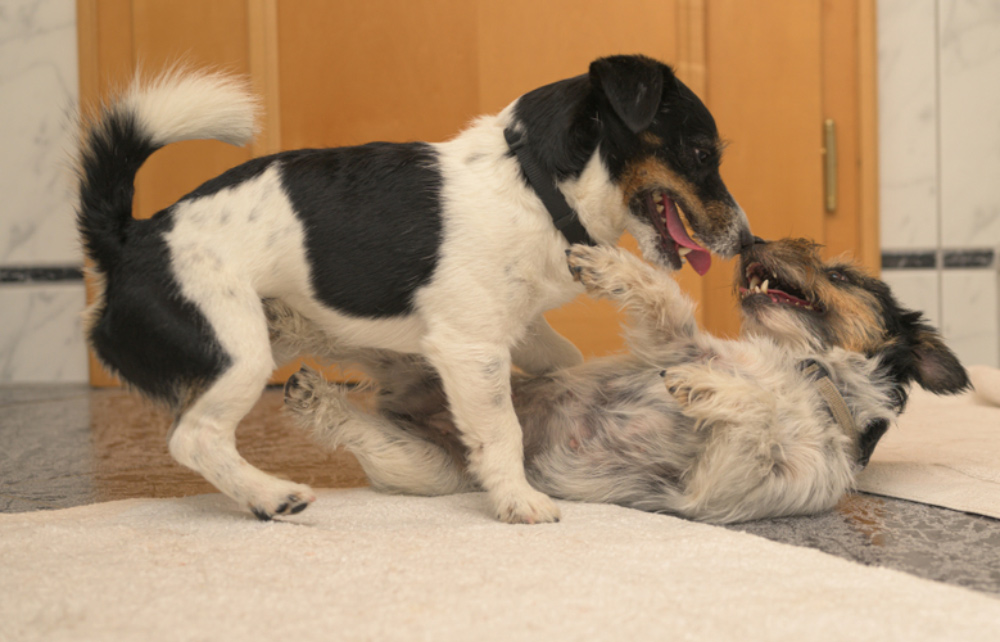Original Article: https://www.dogster.com/dog-behavior/can-two-male-dogs-get-along
Click to Skip Ahead
When it comes to dogs, most of us think the more the merrier! However, some dogs can get aggressive with other dogs, especially those of the same sex, making you wonder if two male dogs can get along. Generally two male dogs can get along if they are properly trained and well socialized. It often helps if both are neutered as well.
If you have a male dog and are concerned about getting a new puppy or rescue of the same sex, we definitely have some advice for you. Keep in mind that every situation will be different, so we highly recommend that you speak to professionals to get tailored advice for ensuring that your two male dogs can get along.


Issues With Two Males Together
While most puppies can run and play together just fine, once they reach sexual maturity, there may be a shift. For most dogs, this happens between 4 and 9 months of age. At this time, you might notice their personality change just a little bit, which may include aggression towards other males.
This aggression may relate to competition, both territorial and reproductive. It may especially become a problem if a female in heat is around or if your males have to share resources.



Tips on Living With Two Male Dogs
Many aspects of same-sex dog aggression can be worked out early on. Here are some ways you can curb or eliminate same-sex dog aggression or fighting and ensure your male dogs get along with each other.
1. Neuter Your Males
Get your dogs neutered. If there’s anything we can say is that sexual hormones can change a dog’s behavior. Speak to your veterinarian about the best time to neuter your dog as it’s best to wait until your dog is fully mature, which can happen at different ages for different breeds.

If you need to speak with a vet but can’t get to one, head over to PangoVet. It’s an online service where you can talk to a vet online and get the personalized advice you need for your pet — all at an affordable price!
2. Proper Training and Socialization
As with anything behavioral in dogs, the more you can expose them to at a young age, the better. Make sure your dogs have been socialized to a lot of different people, animals, and situations and provide them with positive reinforcement when they respond correctly. Responding with aggression should be corrected as soon as possible. Consult a professional if necessary.

3. Always Divide Your Attention Appropriately
You can help eliminate some of the competition by making sure both dogs have their own resources. This includes your time and attention. Give each dog their own one-on-one time as often as possible, and make sure both dogs get their fair share of exercise and mental stimulation in a day.
4. Don’t Let Them Play Fight without Supervision
Dogs love romping around together, however, someone needs to be there to intervene when they’re getting a little too rough. If you don’t directly supervise them, things can get out of hand and the less playful of the two might take what the more playful one does as aggression, leading to fights.
This may include separately crating your dogs when you’re away to give you the peace of mind that they aren’t fighting.
5. Try to Match Personalities
It’s going to be hard for any dogs to get along that have very different personalities. For example, it may be hard for a very active dog to get along with a less active one as their play styles may be very different. These differences can lead to aggression and fighting as one dog may have a hard time taking no for an answer.



When Is Rehoming Necessary?
No one likes to talk about the possibility of rehoming any pet. However, there are certain circumstances where it should be considered.
If you have a particularly aggressive dog that doesn’t respond to training and poses a danger to the people or pets in your household, it might be a good idea to think about rehoming them if you’ve exhausted other options. Ultimately, the health and safety of those in your home come first.
Whether you’re adopting or buying a puppy or a full grown dog, it is your responsibility to provide training and socialization for those pets. Many shelters or breeders will offer a trial period where you get a chance to get to know the dog and see how well they interact with your family and other pets. Take advantage of this time period to ensure a dog is a good fit with your household.


Conclusion
It is possible for two male dogs to get along. That possibility is even higher with the right training and socialization. If you have or are considering getting two male dogs, try following some of these tips to help them get along, or consult your vet or a professional trainer.
Featured Image Credit: SashkaB, Shutterstock
Source: Dogster












